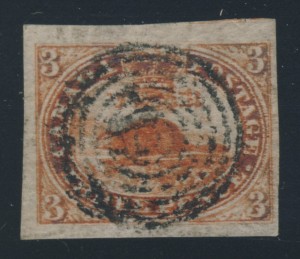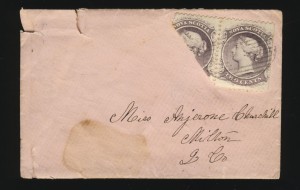The great majority of all stamps can be identified with certainty. When one comes across a stamp which raises questions, however, certainty is often difficult. Questions may concern the catalogue number, whether genuine or not, with or without original gum, with or without postmark, evidence of alterations or repairs, etc. A certificate from a recognized authority can often answer these questions. Certificates are prepared by humans, however, and mistakes can be made between a determination of genuine and not (in either direction!).
Generally speaking one should prefer an opinion which is unequivocal — “is genuine in all respects” or “is a forgery” usually settles the matter. “Appears genuine as far as one can tell” or “no opinion” does not help much. Whole books have been written on the subject.
With this background in mind, we’ll look at two lots in our current auction. Both have certificates from the VG Greene Foundation which is the pre-eminent expert committee for the stamps of Canada and British North America.

1851 3d red Beaver on laid paper, used with three jumbo margins and fourth well clear of outer frameline. 1978 Greene Foundation certificate mentions a “small hole” which is a pinhole not on this stamp, or in the margin but in the portion showing the next stamp at top right. A very fine example of Canada’s first stamp. Unitrade CV$1600.
A careful reading of our description explains how we interpret the rather unflattering description reading “small hole.” This is an example of a harsh Certificate. A Certificate which might be ambiguous about whether the gum is original would be an example of a generous Certificate. Generally speaking, the Greene Foundation is more likely to give a harsh rather than a generous Certificate.

1860 2c lilac, pair one bisected on cover From a new find, backstamped Liverpool, NS APR.22.1868. As the Large Queen issue was introduced in April 1868, many postmasters wished to use up the old Nova Scotia stamps. Three cents was the new Dominion rate. In 2010 the Greene Foundation wrote “the item could be genuine but the lack of a cancel tying the bisect line to cover prevents us from giving an opinion.” Not noted by the Greene Foundation was the lack of evidence of a scoreline in the event someone has used a scalpel or knife to create a bisect and also a faint staining which ties the bisect to the cover. Envelope has a stain and is damaged in upper left and lower left corners. Both stamps have some damage. Unitrade CV$3500.
Here is another example of a lot where we added commentary to the description. I concur with the opinion of perhaps the foremost authority on Nova Scotia postal history that this is genuine. Both of us have examined it thoroughly and have the oral evidence of it being a new find (see also Lot 1269). An April 22 date (the new Dominion stamps were first available April 1) and the fact of a 50% increase in postage at the same time for an in-county Nova Scotia letter suggests that no respectable and frugal correspondent would voluntarily put two of his old colonial stamps on a letter.
However all that background is lost once this envelope changes hands several times. The faint stain which ties the bisect is evidence when the envelope first surfaces but hardly evidence decades from now. The Greene Foundation did not err with its “no opinion.”
For some items a collector has to live without absolute certainty.
